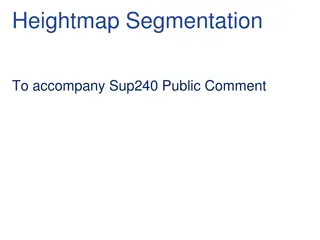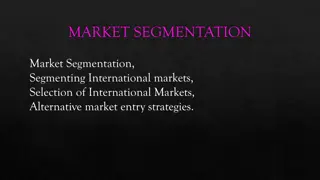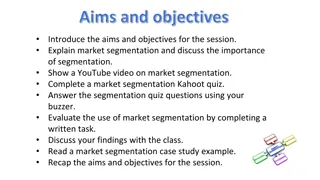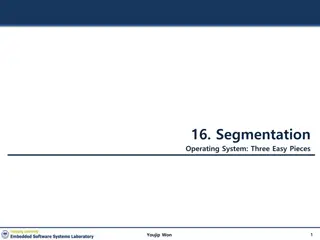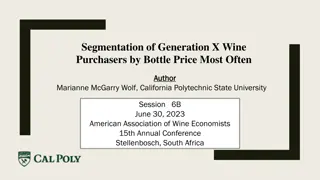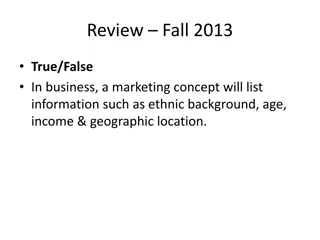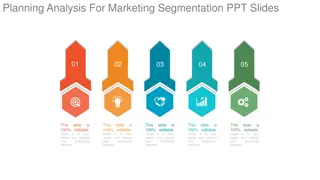Understanding Market Segmentation and Targeting Strategies
Market segmentation involves dividing a market based on distinct needs or characteristics for tailored marketing strategies, while targeting is the process of selecting attractive segments to serve. This process helps in designing a customer-driven marketing strategy by identifying specific customer groups, creating value propositions, differentiating offerings, and positioning them effectively in the market.
Download Presentation

Please find below an Image/Link to download the presentation.
The content on the website is provided AS IS for your information and personal use only. It may not be sold, licensed, or shared on other websites without obtaining consent from the author. Download presentation by click this link. If you encounter any issues during the download, it is possible that the publisher has removed the file from their server.
E N D
Presentation Transcript
Market Targeting Selecting Target Market Segments Target market consists of a set of buyers who share common needs or characteristics that the company decides to serve
Market Targeting Evaluating Market Segments . Segment size and growth Can you meet the growth challenges Competition Segment structural attractiveness Competitors Substitute products Power of buyers Power of supplier Company objectives and resources Strategic fit
1. Market Segmentation 2. Market Targeting 3. Differentiation and Positioning
Market Segmentation Dividing a market into smaller groups with distinct needs, characteristics, or behavior that might require separate marketing strategies or mixes
Market Targeting The process of evaluating each market segment s attractiveness and selecting one or more segments to enter.
Differentiation Actually differentiating the market offering to create superior customer value.
Positioning Arranging for a market offering to occupy a clear, distinctive, and desirable place relative to competing products in the minds of target consumers.
Designing a Customer-Driven Marketing Strategy Select customers to serve Decide on a value proposition Differentiation Differentiate the market offering to create superior customer value. Segmentation Divide the total market into smaller segments. Create value for targeted customers Positioning Position the market offering in minds of target customers. Targeting Select the segment or segments to enter.
Market Segmentation Geographic segmentation Dividing a market into different geographical units such as nations, provinces, regions, parishes, cities, or neighborhoods. Examples World region or country: Western Europe, Middle East, Pacific Rim, China, India, Canada, Mexico, North America Country region: East Asia, South Asia, North Asia Density: Urban, suburban, exurban, rural
Market Segmentation Demographic segmentation Dividing the market into groups based on variables such as age, gender, family size, family life cycle, income, occupation, education, religion, race, generation, and nationality. Examples Age: Under 6, 6-11, 12-19, 20-34, 35-49, 50-64, 65+ Gender: Male, female Family life cycle: Young, single; married, no children; married with children; single parents, Income: Under $20,000; $20,000-$30,000; $30,000- $50,000; $50,000-$100,000; $100,000-$250,000; $250,000 and over
Market Segmentation Psychographic segmentation Dividing a market into different groups based on social class, lifestyle, or personality characteristics. Examples Social class: Lower lowers, upper lowers, working class, middle class, upper middles, lower uppers, upper uppers Lifestyle: Achievers, strivers, survivors Personality: Compulsive, gregarious, authoritarian, ambitious
Market Segmentation Behavioral segmentation Dividing a market into groups based on consumer knowledge, attitudes, uses, or responses to a product. Examples Occasions: Regular occasion; special occasion; holidays; seasonal Benefits: Quality, service, economy, convenience, speed User status: Nonuser, ex-user, potential user, first-time user, regular user User rates: Light user, medium user, heavy user
Can we use multiple segmentation bases? Yes. It can help companies to identify and better understand key customer segments, target them more efficiently, and tailor market offerings and messages to their specific needs.
Requirements for Effective Segmentation Measurable: not too hard to identify and measure Accessible: effectively reached and served Substantial: large or profitable enough to serve Differentiable: worthy to separate segments Actionable: possible to develop separate marketing programs
Customer-Driven Marketing Strategy: Creating Value for Target Customers Lecture 12
Market Targeting Target Marketing Strategies Differentiated marketing targets several different market segments and designs separate offers for each Goal is to achieve higher sales and stronger position More expensive than undifferentiated marketing
Market Targeting Target Market Strategies Concentrated marketing Concentrated marketing targets a small share of a large market Limited company resources Knowledge of the market More effective and efficient
Market Targeting Target Marketing Strategies
Market Targeting Target Marketing Strategies Undifferentiated marketing targets the whole market with one offer Mass marketing Focuses on common needs rather than what s different
Market Targeting Micro Marketing The practice of tailoring products and marketing programs to the needs and wants of specific individuals and local customer groups. Local Marketing tailoring to the needs of cities and neighborhood Individual Marketing - tailoring to the needs of individual customer
Differentiation and Positioning Product position is the way the product is defined by consumers on important attributes the place the product occupies in consumers minds relative to competing products Perceptions Impressions Feelings
Differentiation and Positioning Choosing a Differentiation and Positioning Strategy Identifying a set of possible competitive advantages to build a position Choosing the right competitive advantages Selecting an overall positioning strategy Developing a positioning statement
Differentiation and Positioning Identifying Possible Value Differences and Competitive Advantages Competitive advantage is an advantage over competitors gained by offering consumers greater value, either through lower prices or by providing more benefits that justify higher prices
Differentiation and Positioning Choosing a Differentiation and Positioning Strategy Identifying a set of possible competitive advantages to build a position by providing superior value from: Product differentiation Service differentiation Channel differentiation People differentiation Image differentiation
Differentiation and Positioning Selecting an Overall Positioning Strategy Value proposition is the full mix of benefits upon which a brand is positioned
Differentiation and Positioning Selecting an Overall Positioning Strategy Positioning statement Target market Brand Point of difference
Differentiation and Positioning Selecting an Overall Positioning Strategy Choosing and delivering the chosen position Marketing Mix efforts must support Deliver what you promise







